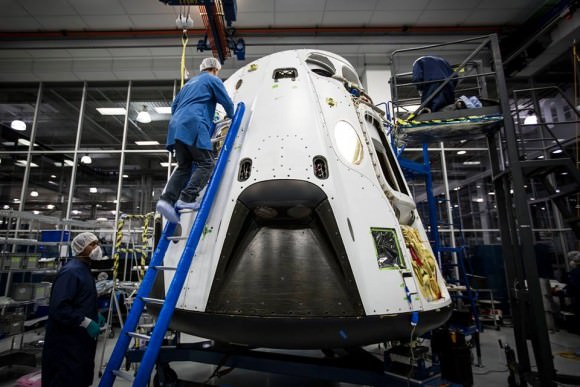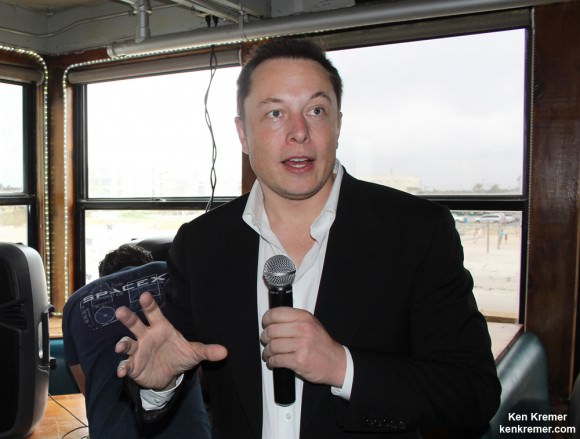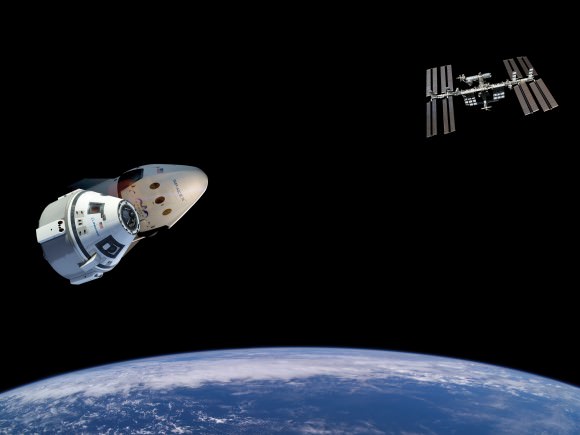SpaceX is preparing for the first of two critical abort tests for the firm’s next generation human rated Dragon V2 capsule as soon as March.
The purpose of the pair of abort tests is to demonstrate a crew escape capability to save the astronauts’ lives in case of a rocket failure, starting from the launch pad and going all the way to orbit.
The SpaceX Dragon V2 and Boeing CST-100 vehicles were selected by NASA last fall for further funding under the auspices of the agency’s Commercial Crew Program (CCP) as the world’s privately developed spaceships to ferry astronauts back and forth to the International Space Station (ISS).
Both SpaceX and Boeing plan to launch the first manned test flights to the ISS with their respective transports in 2017.
During the Sept. 16, 2014, news briefing at the Kennedy Space Center, NASA Administrator Charles Bolden announced that contracts worth a total of $6.8 Billion were awarded to SpaceX to build the manned Dragon V2 and to Boeing to build the manned CST-100.
The first abort test involving the pad abort test is currently slated to take place soon from the company’s launch pad on Cape Canaveral Air Force Station in Florida, according to Gwynne Shotwell, president of SpaceX.
“First up is a pad abort in about a month,” said Shotwell during a media briefing last week at NASA’s Johnson Space Center in Houston, Texas.
SpaceX engineers have been building the pad abort test vehicle for the unmanned test for more than a year at their headquarters in Hawthorne, California.
Dragon V2 builds on and significantly upgrades the technology for the initial cargo version of the Dragon which has successfully flown five operational resupply missions to the ISS.
“It took us quite a while to get there, but there’s a lot of great technology and innovations in that pad abort vehicle,” noted Shotwell.

The pad abort demonstration will test the ability of a set of eight SuperDraco engines built into the side walls of the crew Dragon to pull the vehicle away from the launch pad in a simulated emergency.
The SuperDraco engines are located in four jet packs around the base. Each engine can produce up to 120,000 pounds of axial thrust to carry astronauts to safety, according to a SpaceX description.
Here is a SpaceX video of SuperDraco’s being hot fire tested in Texas:
Video caption: Full functionality of Crew Dragon’s SuperDraco jetpacks demonstrated with hotfire test in McGregor, TX. Credit: SpaceX
For the purpose of this test, the crew Dragon will sit on top of a facsimile of the unpressurized trunk portion of the Dragon. It will not be loaded on top of a Falcon 9 rocket for the pad abort test.
The second abort test involves a high altitude abort test launching atop a SpaceX Falcon 9 rocket from Vandenberg Air Force Base in California.
“An in-flight abort test [follows] later this year,” said Shotwell.
“The Integrated launch abort system is critically important to us. We think it gives incredible safety features for a full abort all the way through ascent.”
“It does also allow us the ultimate goal of fully propulsive landing.”
Both tests were originally scheduled for 2014 as part of the firm’s prior CCiCAP development phase contract with NASA, SpaceX CEO Elon Musk told me in late 2013.
“Assuming all goes well, we expect to conduct [up to] two Dragon abort tests next year in 2014,” Musk explained.
Last year, NASA granted SpaceX an extension into 2015 for both tests under SpaceX’s CCiCAP milestones.

The SpaceX Dragon V2 will launch atop a human rated Falcon 9 v1.1 rocket from Space Launch Complex 40 at Cape Canaveral.
“We understand the incredible responsibility we’ve been given to carry crew. We should fly over 50 Falcon 9’s before crewed flight,” said Shotwell.
To accomplish the first manned test flight to the ISS by 2017, the US Congress must agree to fully fund the commercial crew program.
“To do this we need for Congress to approve full funding for the Commercial Crew Program,” Bolden said at last week’s JSC media briefing.
Severe budget cuts by Congress forced NASA into a two year delay in the first commercial crew flights to the ISS from 2015 to 2017 – and also forced NASA to pay hundreds of millions of more dollars to the Russians for crews seats aboard their Soyuz instead of employing American aerospace workers.
Stay tuned here for Ken’s continuing Earth and planetary science and human spaceflight news.



This should look really cool. Hopefully one day we will see one of these land on the ground coming back from space.